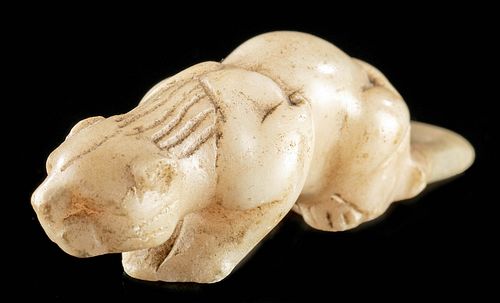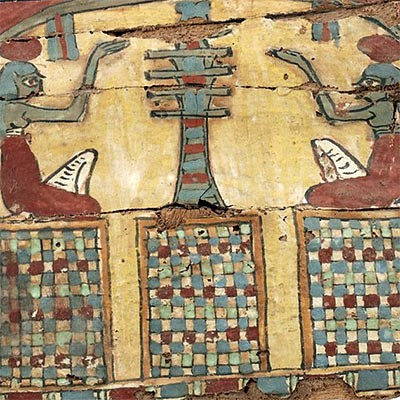Rare South Arabian Alabaster Lion
Lot 53b
About Seller
Artemis Fine Arts
686 S Taylor Ave, Ste 106
Louisville, CO 80027
United States
Selling antiquities, ancient and ethnographic art online since 1993, Artemis Gallery specializes in Classical Antiquities (Egyptian, Greek, Roman, Near Eastern), Asian, Pre-Columbian, African / Tribal / Oceanographic art. Our extensive inventory includes pottery, stone, metal, wood, glass and textil...Read more
Categories
Estimate:
$1,700 - $2,500
Absentee vs Live bid
Two ways to bid:
- Leave a max absentee bid and the platform will bid on your behalf up to your maximum bid during the live auction.
- Bid live during the auction and your bids will be submitted real-time to the auctioneer.
Bid Increments
| Price | Bid Increment |
|---|---|
| $0 | $25 |
| $300 | $50 |
| $1,000 | $100 |
| $2,000 | $250 |
| $5,000 | $500 |
| $10,000 | $1,000 |
| $20,000 | $2,500 |
| $50,000 | $5,000 |
| $100,000 | $10,000 |
| $200,000 | $20,000 |
About Auction
By Artemis Fine Arts
Jul 30, 2020
Set Reminder
2020-07-30 10:00:00
2020-07-30 10:00:00
America/New_York
Bidsquare
Bidsquare : Ancient / Ethnographic From Around the World
https://www.bidsquare.com/auctions/artemis-gallery/ancient-ethnographic-from-around-the-world-5382
Ancient art from Egypt, Greece, Italy and the Near East, as well as Asian, Pre-Columbian, Native American, African / Tribal / Oceanic, Spanish Colonial, Russian Icons, Fine art, much more! All categories, all price ranges... all legally acquired and guaranteed to be as described or your money back. Artemis Fine Arts info@artemisgallery.com
Ancient art from Egypt, Greece, Italy and the Near East, as well as Asian, Pre-Columbian, Native American, African / Tribal / Oceanic, Spanish Colonial, Russian Icons, Fine art, much more! All categories, all price ranges... all legally acquired and guaranteed to be as described or your money back. Artemis Fine Arts info@artemisgallery.com
- Lot Description
South Arabia or the Near East, ca. 1st millennium BCE. A rare and stunning creamy white alabaster sculpture of a lion, shown in a crouched hunting stance, stalking towards its prey. The powerful legs and body are wonderfully depicted, with the long tail curled around the back of the legs. The head is broad, with deeply carved eyes that may once have had inlays, a short snout, delineated nostrils and whiskers, and low, curved ears. Deeply incised lines on the back of the neck create a mane. Size: 3.05" W x 0.95" H (7.7 cm x 2.4 cm)
In ancient times, lions lived in northern Africa and, until around the 20th century BCE, in the ancient Near East. Lions were a popular motif throughout this region; for example, lions flank the gates through which the dead passed at the tomb of King Abargi in Ur, and decorated the private apartments of the Assyrian ruler Ashurbanipal at Kahlu (now at the British Museum). Lions were hunted for sport by the wealthy in this society, and their presence in Arabian and Near Eastern iconography is meant to celebrate both man's prowess over nature and the fierce, threatening power of the wild. The intently hunting posture of this depiction suggests the latter.
Provenance: private New Jersey, USA collection, acquired between 2000 and 2005; ex-Arte Xibalba, Sarasota, Florida, USA
All items legal to buy/sell under U.S. Statute covering cultural patrimony Code 2600, CHAPTER 14, and are guaranteed to be as described or your money back.
A Certificate of Authenticity will accompany all winning bids.
We ship worldwide and handle all shipping in-house for your convenience.
#147651The tail has been reattached in two places; otherwise intact. Slight smoothing to features from touch but form and most details are still in very nice condition. Rich deposits and patina.Condition
- Shipping Info
-
All shipping is handled in-house for your convenience. Your invoice from Artemis Gallery will include shipping calculation instructions. If in doubt, please inquire BEFORE bidding for estimated shipping costs for individual items.
-
- Buyer's Premium



 EUR
EUR CAD
CAD AUD
AUD GBP
GBP MXN
MXN HKD
HKD CNY
CNY MYR
MYR SEK
SEK SGD
SGD CHF
CHF THB
THB















